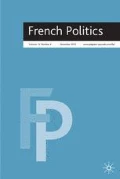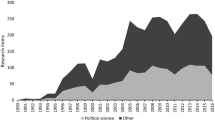Abstract
Forecasting the Extreme Right vote in French elections is one of the few ‘third-party’ forecasts that has attracted attention in a forecasting literature focusing generally on incumbent performance and winners. Despite being a ‘hard case’ because of third-party status, unstable polling estimates and relatively few data points, previous models have provided relatively strong forecasts of the performance of the Front National (FN) and its erstwhile leader, Jean-Marie Le Pen. The recent succession of Le Pen by his daughter, Marine, and her apparent popularity pose a significant challenge to these models, however. In this article, we consider our previous model's prediction of her likely score in the first round of the presidentials, comparing this to standard forecasting benchmarks, and look at possible adjustments to account for the speculated ‘Marine effect’. We then compare this with other vote indicators including the results of an experimental expert judgment survey, finding that there is currently little evidence for a likely runaway success for the new FN leader in April 2012.




Similar content being viewed by others
Notes
Voting intention indicators averaged 16.9 per cent in mid-December 2011, very similar to her father's performance in 2002, but short of the combined 19.2 per cent scored by Le Pen and Bruno Mégret.
We are, of course, aware that in a number of cases, these third parties have in fact joined coalition governments, or polled among the highest vote shares – for example, the Austrian FPÖ and the Norwegian FrP.
Auberger and Dubois control for separate FN effect on Right-wing seats won using a control variable for triangulaires in their model.
See, however, van der Brug and Mughan (2007) who find a diminished role for the ‘charismatic leader’ argument.
Some caution should be exercised in comparing the 2011 performance with the electoral showings of the FN in previous cantonal ballots. First, it must be noted that the FN only ran candidates in about 74 per cent of all renewable cantons, as opposed to over 90 per cent in the past. In 2011, these were not randomly selected, but rather ‘safe bet’ cantons where the party had polled its best scores in 2007. Second, the high level of abstention in the 2011 cantonals (55 per cent compared with about 30–35 per cent previously) might have artificially inflated the FN score.
Standardised seasonally adjusted figures for unemployment rates are expressed as a percentage of the civilian labour force according to the common criteria in the International Labour Organization (ILO) definition. Since November 2007, these are compiled quarterly from the results of the Institut national de la statistique et des études économiques (INSEE) Employment Survey. Their definition differs from that used in the monthly unemployment statistics published by DARES (Ministry of Labour). At the time of writing, official figures show unemployment levels rising in the third quarter of 2011 at 9.8 per cent. However, the latest national statistics published in early December show signs of further deterioration in the labour market in October. Therefore, assuming the psychological impact from media coverage of unemployment, we use the European commission forecast of a 10 per cent rate in 2012, which, in our opinion, better reflects the current aggravation (ec.europa.eu/economy_finance/eu/forecasts/2011_autumn/fr_en.pdf).
Immigration figures were compiled from a number of national and international sources including the OECD, Organisation internationale pour les migrations (OIM), the French Office français de protection des réfugiés et apatrides (OFPRA), Direction de la population et des migrations (DPM) and Ministry of Interior for the post-2002. These exclude all short-term temporary stays by foreigners, students, as well of course as undocumented migrants. Since 2007, some changes have been introduced in the methods employed to collect immigration data from various sources. There are discrepancies between the official statistics published, for instance, by the Ministry of Interior's (formerly Ministry of Immigration and National Identity) SGII-DSED division, and those published by the OFII.
We use Huber–White sandwich estimators to correct for heteroscedasticity.
The MAE gives the mean error from the out-of-sample forecasts, that is, how well each election case is predicted by the other cases in the set.
No evidence of strong cross-correlation between predictors was found, with variance inflation factors (VIF) close to 1 in all three predictors.
A full set of goodness-of-fit measures is available from the authors.
Clearly, immigration statistics increasingly become extremely sensitive politicized issues. In March 2011, Marine Le Pen has, for instance, presented ‘leaked’ figures identifying, she claimed, an increase of more than 42 per cent in the immigration rate in 2011 (www.lepoint.fr/fil-info-reuters/marine-le-pen-brandit-ses-chiffres-de-l-immigration-12-03-2011-1305666_240.php). Were this indeed the case, the immigration parameter in the model would give her some 4 per cent more than the official 2010 figure of 6.8 per cent that we used here.
On average, the 19 second-order elections considered for the analysis took place near mid-term (41.5 per cent of the national election cycle elapsed) when government popularity usually reaches a nadir. As would be anticipated, a negative correlation was also found between the temporal location of the second-order election and Prime Ministerial popularity as measured in the TNS-SOFRES series since the late 1970s (r=−0.56, p=0.006, n=19).
It should be noted that testing this model on the first-order elections provided woefully inaccurate forecasts – worse than running the first-order model on the second-order elections. Both of these trials are available from the authors on request.
Notably, the new top-level leadership that has emerged from the XIVth party congress in January 2011 has accommodated a number of former mégrétistes such as Steeve Briois, Bruno Bilde and Nicolas Bay.
Our test is far less robust than Hofstee and Schaapman's, lacking as it does, for instance, any control group. However, we still feel it provides a useful expert benchmark.
Specifically: OpinionWay, 18 per cent (24 November 2011); SOFRES, 16.5 per cent (26 November 2011); IFOP, 19.5 per cent (30 November 2011); BVA, 17 per cent (03 December 2011); IPSOS, 17 per cent (03 December 2011) and LH2, 13.5 per cent (10 December 2011).
See ‘Les électeurs FN sont plus nombreux à assumer leur vote’ (Le Monde, 19 November 2011).
Participating experts were asked the following question: What is your own estimate, today, of Marine Le Pen's score in the first round of the 2012 Presidential election?
LH2 poll for Yahoo!, 20 November 2011, www.lh2.fr/_upload/ressources/sondages/politique_nationale/lh2yahoointentionsvotepresidentielle201220nov_2011.pdf.
References
Arzheimer, K. and Evans, J. (2010) Forecasts of the French legislative vote from regional economic conditions. International Journal of Forecasting 26 (1): 19–31.
Auberger, A. (2007) Economy, politics and results of the French presidential elections. Paper presented at the Public Choice meeting; April, Amsterdam.
Auberger, A. and Dubois, E. (2005) The influence of local and national economic conditions on French legislative elections. Public Choice 125 (3–4): 363–383.
Bélanger, E., Nadeau, R. and Lewis-Beck, M.S. (2010) Forecasting the vote for a third party: The British liberals, 1974–2005. British Journal of Politics and International Relations 12 (4): 634–643.
Benoit, K. and Laver, M. (2006) Party Policy in Modern Democracies. London: Routledge.
Betz, H.-G. (1994) Radical Right-Wing Populism in Europe. London: Palgrave Macmillan.
Campbell, J. (1996) Polls and votes: The trial-heat Presidential election forecasting model, certainty, and political campaigns. American Politics Quarterly 24 (4): 408–433.
Evans, J. and Ivaldi, G. (2008) Forecasting the extreme right vote in France (1984–2007). French Politics 6 (2): 137–151.
Evans, J. and Ivaldi, G. (2010) Comparing forecasts of radical right voting in four European countries. International Journal of Forecasting 26 (1): 82–97.
Evans, J. and Ivaldi, G. (forthcoming) Deriving a forecast model for European election turnout. Political Research Quarterly.
Graefe, A., Armstrong, J.S. and Jones, R.J. (2011) Combining forecasts: An application to election forecasts. Paper delivered to the APSA Annual Meeting; September, Seattle, http://papers.ssrn.com/sol3/papers.cfm?abstract_id=1902850.
Hofstee, W. and Schaapman, H. (1990) Bets beat polls: Averaged predictions of election outcomes. Acta Politica 25 (3): 194–207.
Huber, J. and Inglehart, R. (1995) Expert interpretations of party space and party locations in 42 societies. Party Politics 1 (1): 73–111.
Ivarsflaten, I. (2005) The vulnerable populist right parties: No economic alignment fuelling their electoral success. European Journal of Political Research 44 (3): 465–492.
Jérôme, B. and Jérôme-Speziari, V. (2003) A Le Pen vote function for the 2002 presidential election: A way to reduce uncertainty. French Politics 1 (2): 247–251.
Jérôme, B. and Jérôme-Speziari, V. (2004) Forecasting the 2002 elections: Lessons from a political economy model. In: M. Lewis-Beck (ed.) The French Voter Before and After the 2002 Elections. London: Palgrave Macmillan, pp. 178–204.
Jérôme, B., Jérôme-Speziari, V. and Lewis-Beck, M. (1999) Polls fail in France: Forecasts of the 1997 legislative election. International Journal of Forecasting 15 (2): 163–174.
Jones, R.J., Armstrong, J.S. and Cuzán, A.G. (2007) Forecasting elections using expert surveys: An application to US Presidential elections. Prepared for presentation at the annual meeting of the American Political Science Association; 2 September, Chicago, http://repository.upenn.edu/marketing_papers/137/.
Kitschelt, H. and McGann, A. (1995) The Radical Right in Western Europe. A Comparative Analysis. Ann Arbor, MI: University of Michigan Press.
Lewis-Beck, M. (1985) Election forecasts in 1984: How accurate were they? PS: Political Science and Politics 18 (1): 53–62.
Lewis-Beck, M. and Rice, T. (1992) Forecasting Elections. Washington DC: CQ Press.
Lewis-Beck, M.S. and Tien, C. (2010) The referendum model: A 2010 congressional forecast. PS: Political Science and Politics 43 (4): 637–638.
Lubbers, M., Gijsberts, M. and Scheepers, P. (2002) Extreme right-wing voting in Western Europe. European Journal of Political Research 41 (3): 345–378.
Mayer, N. (2002) Ces Français qui votent Le Pen. Paris, France: Flammarion.
McElroy, G. and Benoit, K. (2010) Party policy and group affiliation in the European parliament. British Journal of Political Science 40 (2): 377–398.
Mudde, C. (2007) Populist Radical Right Parties in Europe. Cambridge, UK: Cambridge University Press.
Nadeau, R., Lewis-Beck, M.S. and Belanger, E. (2010) Electoral forecasting in France: A multi-equation solution. International Journal of Forecasting 26 (1): 11–18.
Pedahzur, A. and Brichta, A. (2002) The institutionalization of extreme right-wing charismatic parties: A paradox? Party Politics 8 (1): 31–49.
Perrineau, P. (1998) Le symptôme Le Pen. Radiographie des électeurs du Front national. Paris, France: Fayard.
Pickup, M. and Johnston, R. (2008) Campaign trial heats as election forecasts: Measurement error and bias in 2004 presidential campaign polls. International Journal of Forecasting 24 (2): 272–284.
Schmitt, H. (2005) The European Parliament elections of June 2004. Still second-order? West European Politics 28 (3): 650–679.
van der Brug, W. and Mughan, A. (2007) Charisma, leader effects and support for Right-wing populist parties. Party Politics 13 (1): 29–51.
Author information
Authors and Affiliations
Corresponding author
Rights and permissions
About this article
Cite this article
Evans, J., Ivaldi, G. Forecasting the FN presidential vote in 2012. Fr Polit 10, 44–67 (2012). https://doi.org/10.1057/fp.2011.21
Published:
Issue Date:
DOI: https://doi.org/10.1057/fp.2011.21




